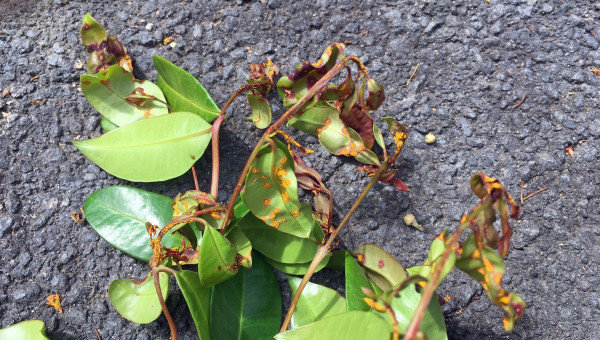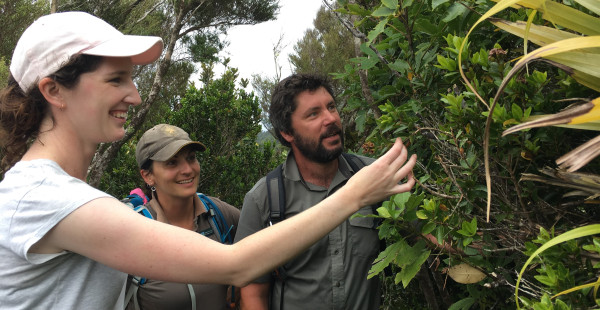What's the risk from myrtle rust?
Myrtle rust reproduces rapidly, in as little as two to four weeks and can continue to damage new growth of infected plants repeatedly.
Myrtle rust affects the new growth of infected plants. Trees are not able to regenerate and due to repeated infections over time can eventually die. Continued infection weakens their immune systems, which can expose them to other diseases, as the plants need to put resources into fighting the disease instead of growing.
Young plants are especially vulnerable as they often only have soft, new growth that becomes infected and they cannot grow new leaves or shoots.

Repeated infection causes leaves to become twisted and die
Myrtle rust also makes plants more susceptible to secondary infections, in the same way that people with an immune deficiency may contract illnesses more easily than normal. Any secondary infections from pests, like possums or insects, could be the tipping point for these affected plants. Also, environmental conditions like drought can, have a devastating effect on an infected tree.
Risk to New Zealand myrtles
Myrtle rust poses a major threat to New Zealand’s native biodiversity and ecosystems given that many native species rely on healthy trees for their survival.
In New Zealand our understanding around susceptibility continues to increase. Some examples where risk is high include:
- Lophomyrtus bullata, Ramarama - this is a highly susceptible native myrtle species, also known as bubble leaf (Lophomyrtus bullata and its hybrids). This attractive native species is used widely in large-scale plantings as well as in residential and commercial hedging, where the dense young growth that results from repeated pruning may help to create an ideal environment for the fungus to rapidly grow and spread.
- Syzygium maire, Maire tawake is severely susceptible and experiences infection on leaves, stem and flower structures. It is facing functional extinction in some areas where trees are unable to produce viable seeds.
- Lophomyrtus obcordata, Rōhutu are severely susceptible
- Metrosideros excelsa, Pōhutukawa are highly susceptible, with infection on leaves, stem, flowers, seed capsules, seedlings and epicormic shoots. Substantial increase in infection was noted in summer 2022–23
An extensive list of susceptibility is available:
Download Myrtle Rust Susceptible Host Species [PDF, 477KB]
The Conservation status of all native Myrtaceae was raised in 2018 after the arrival of myrtle rust, for all species the status was elevated to 'Threatened'. This includes:
- Nationally vulnerable (16 species)
- Nationally critical (10 species)
- Nationally endangered (1 species)
If there are high impacts on keystone forest species like pōhutukawa and rātā other native flora and fauna in those ecosystems are also likely to suffer significant impacts.
Myrtle rust attacks new shoots, fruits and flowers, and can destroy the food relied on by some species of native birds, lizards and insects. There is the possibility that some of these species could become regionally extinct, and their loss could have serious flow-on effects to ecosystem services like erosion control and nutrient cycling.

A team collecting seed to preserve future myrtles. Photo courtesy of the Department of Conservation
There remains an urgent need for seed and germplasm collection and conservation nationally. There is an urgent need to fill seed banks with a diversity of seeds to ensure a strong gene pool for the future.
New Zealand's ecosystems are already under huge pressure from introduced pests. We are also seeing increasingly severe weather events like droughts and strong weather patterns that will, in combination with disease and pests, have impacts.